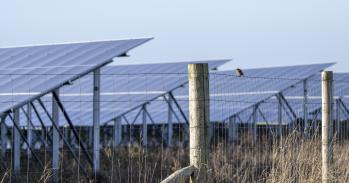
Aditya Sadhanala wanders over to the wall, turns a pulley, and a wooden box about a metre squared swings up and away. Below it gleams an array of carefully positioned lasers, deflectors and sensors surrounding a piece of glass no bigger than a contact lens. He flips a switch and creates a ‘mirage’.
Aditya Sadhanala wanders over to the wall, turns a pulley, and a wooden box about a metre squared swings up and away. Below it gleams an array of carefully positioned lasers, deflectors and sensors surrounding a piece of glass no bigger than a contact lens. He flips a switch and creates a ‘mirage’.
India may well leapfrog the UK in taking up radical new approaches to power generation
Richard Friend
This is a photothermal deflection spectrometer (PDS) and the mirage – only the width of a human hair in distance from the glass – is helping researchers to measure the quality of materials that turn light energy into electricity.
“We can see one defect in a million molecules,” explains Sadhanala, who built the machine while working on his PhD in the lab of Professor Sir Richard Friend. “The PDS technique measures the amount of light absorbed by a material with up to five orders of magnitude more sensitivity than conventional techniques, making it one of the most sensitive absorption spectrometers in the world.”
A mirage is formed as light is bent when it passes through a medium with varying refractive index – a puddle of water seems to appear on the road ahead, for instance, when light meets hotter air radiating from the ground on a sunny day.
Sadhanala’s machine creates a mirage effect when light absorbed by the solar material is released as heat, which passes to a liquid that surrounds the sample. When a laser beam is directed to pass parallel to it, the mirage deflects the beam; the amount of deflection corresponds to the amount of heat absorbed, which in turn corresponds to the amount of light absorbed.
“Before, we would have had to make a whole solar device and spend months and months testing it to find out how efficient the material is,” explains Sadhanala. “Now you can measure a new material in half a day, and you don’t even need to make the whole device – you just need to be able to coat the material onto glass and make a mirage.”
A few weeks ago, Tushita Mukhopadhyay – a chemist at the Indian Institute of Science, Bangalore – carefully packaged up five new materials and flew to the UK to test them on the ‘mirage machine’ in Cambridge, and analyse other properties with researchers at Imperial College London. She had spent months making and characterising the materials – all of them belonging to a group of organic solar cells (OSCs) that can be printed as thin-film sheets.
What connects the two researchers, and indeed many other chemists, physicists and engineers, is the APEX project – an ambitious Anglo-Indian initiative to turn fundamental advances in solar materials into commercial reality.
APEX involves research institutes in Bangalore, Delhi, Hyderabad, Kanpur and Pune in India, and Brunel (which leads the partnership), Cambridge, Edinburgh, Imperial, Swansea and Oxford in the UK, plus solar industries in both countries. It has received almost £6 million funding since 2010 from the Indian Department of Science and Technology and Research Councils UK.
“Solar has always been the eventual solution to our energy problems but it’s always been the day after tomorrow,” explains Friend, who leads the Cambridge component. “Each of the partners in this project has an extensive research programme aimed at developing highly efficient photovoltaic devices, but there is a disconnect between what you can do in the lab and what can be rolled out at huge scale. This project is aimed at moving from established science to a viable technology.”
First though, there is the matter of achieving a major cost reduction and efficiency increase in solar power. The APEX team started by focusing on developing a new class of ‘excitonic’ solar cell (which produces electricity from the sun’s energy through the creation of an ‘exciton’ – essentially a free electron). Instead of using the conventional solar material, silicon, the researchers used solar materials made from organic dyes – dye-sensitised solar cells (DSSCs) – which are easy to make, easy to process and cost less.
However, one of the main issues surrounding the search for alternative solar materials to silicon has been their power conversion efficiencies (PCEs) – the amount of the sun’s energy that can be trapped and turned into electricity.
The PCE for silicon is around 25%, whereas the current state-of-the-art PCE figures for DSSCs and OSCs are a little over 10%. To achieve incremental boosts in these figures, researchers like those in Friend’s group have been analysing what happens at the nanoscale when light hits the material. For instance, they now know that manipulating the ‘spin’ of electrons in solar cells can dramatically improve their performance.
Mukhopadhyay, who travelled to the UK thanks to funding through the UK–India Education and Research Initiative, explains: “My materials have a fast charge transport rate – as we’ve now proved at Cambridge and Imperial – but they have a low PCE. We think that a process called singlet fission, in which one exciton splits into two, is happening. This makes them interesting to look at because if more than one charge carrier is generated then this can increase the PCE.”
Another family of materials the team has high hopes for is a set of perovskite-structure lead halides. Work at the University of Oxford has already achieved a PCE of above 17% for such materials, and Sadhanala has begun using his machine to see the effect of different processing methods on their properties.
As well as developing cheap, high-performing solar materials, the team will scale up towards prototypes that replicate the performance achieved in the research phase.
Although the aim is to provide a technology that can reduce the carbon footprint of electricity generation anywhere in the world, solar energy could fulfil a massive demand for energy in India. India is the fifth largest producer and consumer of electricity, around 70% of which is based on coal, yet around 200 million people are without access to electricity. With a rapidly growing economy and more than 1 billion people, India faces a huge energy challenge to meet the current government’s mission of ‘Power for all, 24x7, by 2019’.
In fact, India could be an ideal place to adopt new solar technologies on a large scale, says Friend: “India is already currently running the largest renewable capacity expansion programme in the world, and there is a sense that the next technology revolutions may well happen in an emerging country like India that hasn’t already built its future renewables-heavy electricity system.”
“India may well leapfrog the UK in taking up radical new approaches to power generation,” he adds. “We want APEX to contribute to the search for such approaches now and in the future. This is a journey, not a day’s outing.”

The text in this work is licensed under a Creative Commons Attribution 4.0 International License. For image use please see separate credits above.




